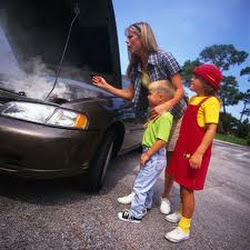The temperatures are climbing – 90, 95, 100. You’re stuck in traffic, and it’s hot!
You look over to the side of the road. Standing there is a person with the hood of their car propped open, smoke pouring out in all directions. Their car is overheating.
Aren’t you glad it’s not you?
Yet you stop to think about the probability of you being in the same situation. Your vehicle is several years old. You change the oil, put new tires on periodically. Maintenance? You bring it in when there seems to be a problem. What more can you do?
Are you in a situation where your car might overheat?
Why a car overheats
Your car’s engine can overheat for a variety of reasons. In most cases, it’s because something is wrong with the cooling system, and the heat isn’t able to escape the engine compartment. The source of the cooling system issue could be many things, including:
- A cooling system leak
- A faulty radiator
- A broken water pump
- A clogged coolant hose
No matter what causes an issue, allowing your engine to overheat in any way isn’t something you want to linger. The longer it goes unchecked, the more damage your engine can sustain. Until it eventually sustains permanent damage and can’t be repaired.
What are the signs of an engine overheating?
Luckily, an engine doesn’t overheat without a few warning signs along the way. This is why it’s good to pay attention to your vehicle as it ages. If you see any of these warning signs, take steps to cool your engine before it overheats more. You may be able to reduce the risk of irreversible engine damage. Signs of overheating include:
Steam – this is the one thing we all recognize when we see people pulled over to the side of the road. If you notice any amount of steam leaking from underneath the hood, pull over as quickly as you can.
The engine temperature gauge increasing – the monitors on your dashboard are there to warn you of potential problems. If you see the temperature gauge increasing, spiking up towards “H” or to the red, it’s time to pull over and turn off your engine. (Temperature gauge icons change depending on the make and model of your car. Take the time to become familiar with your vehicle before you drive it.)
A strange smell coming from the engine compartment – if anything is leaking, it’s going to give off a smell outside of ordinary. Coolant has a very distinctive sweet smell, while oil dripping anywhere into the engine compartment would create a burnt smell.
If you notice any of these symptoms of overheating, pull over as soon as you can, turn off your vehicle, and let the engine compartment cool down.
The engine is overheating … now what?
When you first see warning signs of an engine overheating, time is of the essence. The faster you act, the greater chance you have of limiting damage, meaning less cost from repair bills. If you notice any of the signs from above, do these things.
Turn off the air conditioner and crank up the heat.
You often see cars by the side of the road, smoke billowing from underneath the hood, in the middle of a heatwave. When you’re running your air conditioner at high for miles, it adds stress to the engine. If it’s weakened to begin with, it can be more than it can handle. To reduce the stress, turn the air off and dial it to maximum heat. This can help pull the heat away from the engine to keep it from overheating. This gives you a chance to find a safe place to pull over.
Safety first
Immediately look for a safe place to pull over. This isn’t the time to put your safety at risk – cars are easier to replace. Put your car into park and shut off the car. This gives the engine a chance to cool. Keep the engine off for at least 15 minutes. You can also keep an eye on the temperature gauge, as it should move back to the normal range as the engine cools.
Check your coolant levels
After your vehicle cools down, you can check to see if your coolant level is low. If it is, topping it off and adding more coolant can prevent overheating and allow you a chance to bring your vehicle in to get things fixed. Keep in mind that this step won’t do much good if the coolant hose is clogged, or if the problem stems from a broken fan or water pump. If you’re unsure, towing your vehicle might be the safest route.
Restart your car
If your car appears to be back to normal, and you’ve chosen to drive it to a mechanic, start the car and watch all signs while you carefully drive your car to the repair shop. Keep an eye on the temperature gauge. If it rises again, pull over and consider having it towed.
The key to lowering your repair risks is not to panic. If at all possible, pull over, turn the vehicle off, and don’t keep driving. This exacerbates the problem.
Also, be aware that you should never open the hood immediately as soon as you pull over. That steam is hot! Opening it could put you at risk of burns and injuries. Let the temperature gauge settle before popping the hood.
How to prevent your car from overheating
The easiest way to recover from an overheated vehicle is never to have it overheat in the first place. Taking care of your car ensures that it will always be there for you.
This means scheduling regular inspections to allow a mechanic to inspect and test every system of your car. This can find minor problems that can snowball. Regular coolant flushes can keep fresh coolant inside your vehicle, and prevent leaks and blockages by finding them before they become a problem.
You can also stay up to date on all other maintenance items, such as ensuring your radiator is inspected and in good shape, according to manufacturer’s guidelines.
It’s far more beneficial and less expensive for checkups each season than allowing your car to show signs of a potential problem, and waiting until your car breaks down.
Schedule your maintenance visit today.


